

 Vol. 40 (Number 19) Year 2019. Page 28
Vol. 40 (Number 19) Year 2019. Page 28
GELISLI, Yucel 1; KAZYKHANKYZY, Lazura 2; MANKESH, Aksaule 3; SHAUYENOVA, Meruyert 4 & AKHMETOVA, Aigul 5
Received: 25/09/2018 • Approved: 29/05/2019 • Published 10/06/2019
ABSTRACT: The purpose of this research was to determine the relation between the academic self-concept (ASC) and L2 motivational self-system (MSS) of pre-service English teachers in Kazakhstan. The study employed a survey model to collect the data. Quantitative methods of data analysis were used to analyze the data with the help of statistical software package SPSS version 22.0. Descriptive analyses (mean, standard deviation), Mann-Whitney U test, Kruskal-Wallis H test and Spearman rank-order correlation coefficient were conducted to analyze the data. The results revealed that Kazakhstani pre-service English teachers’ have overall high levels of academic self-concept and L2 motivational self-system. Finally, correlation analysis results indicated a positive relationship between academic self-concept and L2 motivational self-system of English pre-service teachers. |
RESUMEN: El propósito de esta investigación fue determinar la relación entre el autoconcepto académico (ASC) y el auto-sistema motivacional (MSS, por sus siglas en inglés) L2 de los profesores de inglés en servicio en Kazajstán. El estudio empleó un modelo de encuesta para recopilar los datos. Se utilizaron métodos cuantitativos de análisis de datos para analizar los datos con la ayuda del paquete de software estadístico SPSS versión 22.0. Se realizaron análisis descriptivos (media, desviación estándar), prueba U de Mann-Whitney, prueba H de Kruskal-Wallis y coeficiente de correlación de orden de rango de Spearman para analizar los datos. Los resultados revelaron que los profesores de inglés pre-servicio de Kazakhstani tienen altos niveles generales de autoconcepto académico y auto-sistema motivacional L2. Finalmente, los resultados del análisis de correlación indicaron una relación positiva entre el autoconcepto académico y el auto-sistema motivacional L2 de los profesores de inglés antes del servicio. |
There is agreement among the different researchers’ in that the self-concept is one of the important constructs in psychology and education. The importance of self-concept stems from its notable contribution to personality formation. Academic Self-concept is one of the affective variables which effect learning process, in other words the learner’s success. Many researchers define academic self-concept as a student’s belief about him/herself on how more talented he/she feels of himself in comparison to other students in an academic work (Arseven, 1979). In other words, academic self-concept is “a person’s perception of self with respect to achievement in school”(Reyes, 1984, p. 558). These self-perceptions associated with academic self-concept focuses on scholastic competence, rather than attitudes. A student’s self perception of academic ability affects his/her school performance (Marsh, 1990).
Psychologists have already proved the importance of self-concept in an individual’s personal development. Similarly, educators are also agreeing that a student’s perception of him/herself have a significant influence on his/her academic performance. Numerous studies done over the years have confirmed the positive relation between these two variables.
Motivation is another crucial factor involved in L2 learning. L2 motivation is defined as, “the extent to which an individual strives to learn the language because of a desire to do so and the satisfaction experienced in the activity” (Gardner, 1985, p. 10). It is accepted by the researchers that motivation is the major factor which “determines human behaviour by energizing it and giving it direction” (Dörnyei, 1998, p. 118). Therefore, motivation has been accepted by the researchers and educators as one of the key elements influencing the rate and success of L2 learning.
The L2 motivational self system paradigm proposed by Dornyei (2005) is based on the concepts of “Possible Selves” by Markus and Nurius, (1986) and the “Self-discrepancy theory” by Higgins (1987, 1998). Dörnyei (2005, 2009) proposed that the L2 motivational self system model comprises of three main dimensions: The ideal L2 self, the ought to L2 self, and the L2 learning experience.
The ideal L2 self, which is “the L2-specific aspect of one’s ideal self” (Dornyei, 2005, p.106), represents an ideal image one aspires to be in the future. If one wants to be a fluent L2 user who interacts with international friends, for instance, the imaginary picture of one’s self as a fluent L2 user might act as a powerful motivator to reduce the discrepancy between the here-and-now or actual self and this ideal image.
The second dimension of L2 motivational self system the ought-to L2 self refers to the attributes that one believes one ought-to possess as a result of perceived duties, obligations, or responsibilities (Dörnyei, 2005). For instance, if a person wants to learn an L2 in order to meet the expectations of significant others, ought-to L2 self can act as the main motivator for L2 learning.
The third component the L2 learning experience concerns learners’ attitudes toward second language learning and can be affected by situation-specific motives related to the immediate learning environment and experience.
A large body of research has examined the relations between academic achievement and academic self-concept or L2 motivational self system and academic performance. However, the aim of this research was the investigation of the effects of L2 motivational selves of learners on academic self-concept. Although the literature suggests motivation and self-concept are related to one another, few studies have simultaneously examined the interrelation between these factors. Thus, this paper seeks to address the issue of relations between academic self-concept and L2 motivational self. Specifically, the study is focused on the effect of gender, grades and attended university on academic self-concept and L2 motivational self system among Kazakhstani pre-service English teachers.
Research questions:
In the present study a quantitative research design was adopted, which is according to Aliaga and Gunderson (2002, p.1) “explains phenomena by collecting numerical data that are analyzed using mathematically based methods (in particular statistics)”. In this study, a survey model as a type of quantitative research design was used to collect the data which results are highly generalizable. According to Balnaves and Caputi (2001) a survey study is “…a method of collecting data from people about who they are (education, finances, etc.), how they think (motivations, beliefs, etc.), and what they do (behavior).” (p. 76).
The study was conducted in EFL teacher training program at two universities in South part of Kazakhstan. The participants of this study were chosen through convenience sampling which is according to Fraenkel and Wallen (2006) “a group of individuals who (conveniently) are available for study” (p. 98). This is the most widely used sampling method in education research which is beneficial in terms of time, money and effort it takes. This sampling method is among the most widely used ones in educational research and it is quite advantageous in terms of time, money and effort it takes (Muijs, 2010). A total of 307 undergraduate students enrolled in the departments voluntarily participated in the study. The 2nd (45.2%), 3rd (44.2%) and 4th (10.4%) year students comprised of 55 males (17.90%) and 252 (82.10%) females were chosen for the current research.
Two instruments were used in the current study. The first instruments for collecting data was the Academic Self-Concept Scale (ASCS) developed by Liu & Wang (2005), which consisted of two subscales nominated “academic confidence” and “academic effort”. Academic confidence subscale assesses students’ enjoyment and willingness to work hard in their academic subjects and academic effort measures students’ commitment to and involvement and interest in schoolwork. The instrument had 19 items on a 5 point Likert type, point responses of which were edited as 5 = totally agree; 4 = agree; 3 = partially agree; 2 = disagree; 1 = totally disagree. The internal consistency estimates of reliability for the 19-item ASC scale, 9-item AC subscale, and the 10-item AE subscale in the present study are .95, .70 and .74, respectively.
L2 motivational self system of participants was measured using subscales adapted from Taguchi et al.(2009) questionnaire. It includes many variables such as ideal and ought to selves, attitudes towards English learning, attitudes towards L2 community, family influence, cultural interest, integrativeness and so on. However, among its large number of subscales, only those ones referring to ideal self, ought to self, and attitudes towards English learning subscales were adopted in the current study. Cronbach’s alpha value for ideal L2 self was α = .92, for ought to L2 self was α = .87, and α = .87 for attitudes towards English learning.
Firstly, in order to describe the ASC and L2 MSS of participants descriptive analyses (means, standard deviations) were carried out on the sample. As the data did not meet normality assumption for the employment of parametric tests, non-parametric tests were performed.Mann-Whitney U test was used in order to compare the average scores of participants according to gender and attended universities. The Kruskal-Wallis H test was conducted to examine the difference among participants, according to their grades. Moreover, Spearman rank-order correlation coefficient was performed to investigate whether or not the relation exists between academic self concept and L2 motivational self system.
Initially descriptive statistics were conducted in order to understand ELT student-teachers’ levels of academic self-concept in terms of academic confidence and academic effort, at the same time, L2 motivational self system in terms of Ideal L2 self, ought to L2 self and attitudes towards English learning (Table 1).
Table 1
Mean Scores and Standard Deviations
of the ASC and MSS and Its Subscales.
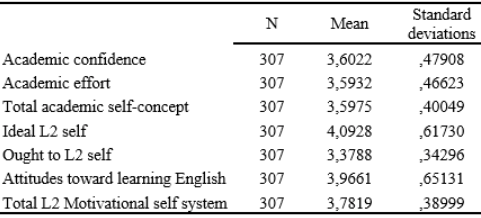
According to the score distribution, where the score interval between 1.00-1.80 (Totally insufficient) means too weak level of self-sufficiency, 1.81 – 2.60 (Insufficient) weak level of self-sufficiency, 2.61 – 3.40 (Partially sufficient) medium level of self-sufficiency, and 3.41 – 4.20 (Sufficient) high level of self-sufficiency, the participants appeared to have the highest mean values in Ideal L2 self (X̅ = 4.09) indicating that L2 had the most significant part in their ideal selves. It was followed by the attitudes towards English learning which results indicated high level of self-sufficiency (X̅ = 3.96). The lowest mean value participants reported in terms of ought to L2 selves (X̅ = 3.37).
Further, in order to answer the second research question, whether pre-service English teachers’ ASC and L2 MSS levels vary according to their gender, Mann-Whitney U test was conducted for the data to investigate the difference between male and female pre-service teachers in terms of their levels of academic self-concept and L2 motivational self-system (table 2).
Table 2
The Mann-Whitney U test results for the effect
of gender on pre-service teachers’ ASC and MSS
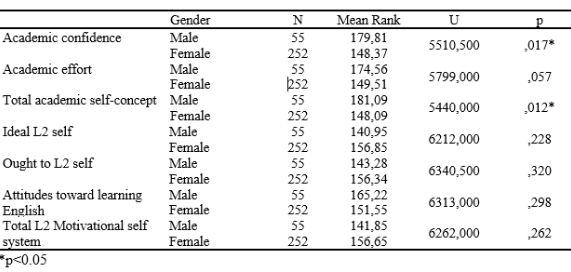
Statistical analysis of data clearly established that there were no statistically significant differences between Kazakhstani male and female pre-service English teachers with respect to their motivational self-system and its dimensions (male MR=141.85; female MR=156.65; H=6262.0; p=.262). However, significant difference was found in terms of participants’ academic self-concept (male MR=181.09; female MR= 148.09; U=5440.0; p=.012). Male participants showed higher degree of academic confidence (MR=179.81) than female participants (MR=148.37).
Next, to explore the effect of studying universities on participants’ academic self-concept and L2 motivational self-system, a Mann-Whitney U test was performed on the data. The results of the analysis presented in table 3.
Table 3
The Mann-Whitney U test results for the effect of attended
universities on participants ASC and MSS levels
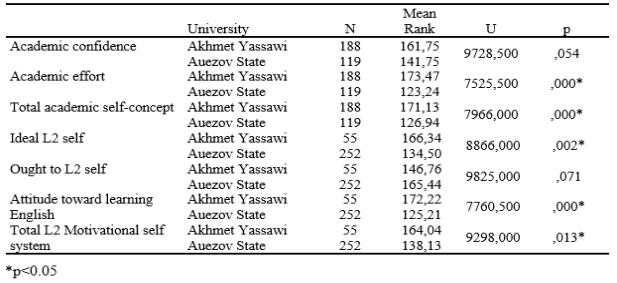
According to the results, the differences were found in terms of participants’ academic effort (U=7525.5; p=.000), and overall academic self-concept (U=7966,0; p=,000). It can be seen that Akhmet Yassawi university pre-service teachers’ had higher academic effort (MR = 173.47) and more positive academic self-concept (MR = 171.13) than Auezov State university pre-service teachers’ (MR = 126.94).
The results of L2 motivational self-system demonstrated similar results. The average result on the L2 motivational self-system scale of Akhmet Yassawi university pre-service teachers’ was MR = 164.04, while Auezov State university pre-service teachers mean rank was X= 138.13, which indicated significant difference between the two groups (U=9298; p=,013). Similarly, statistically higher results were reported by Akhmet Yassawi university students in terms of their levels of Ideal self and Attitudes towards English learning.
Further, to investigate the effect of grades on participants academic self-concept and L2 motivational self-system, a Kruskal-Wallis H test was conducted.
Table 4
Kruskal-Wallis H test results for the effect of grades on
Kazakhstani pre-service teachers’ academic self-concept
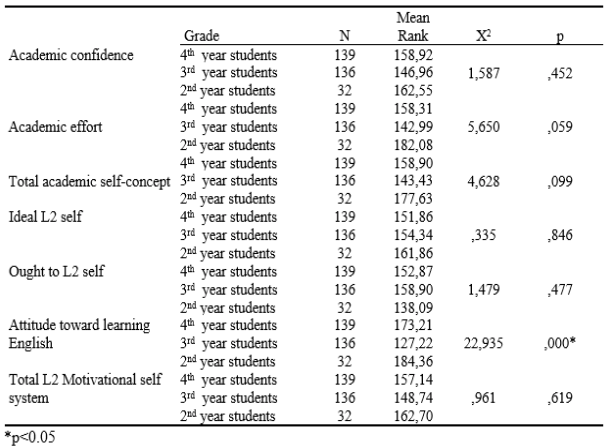
The analyses revealed that the difference was not statistically significant among the 2nd, 3rd and 4th year pre-service teachers based on their levels of academic self-concept and L2 motivational selves, with a p>.05. The only difference was found on the participants’ attitudes towards English learning according to their grades. Here, we can observe that 2nd year students reported higher results that their counterparts (see table 3).
Finally, in order to answer the last research question, whether there is any relation between academic self-concept and L2 motivational self-system of pre-service English teachers, the Spearman rank-order correlation coefficient was computed for participants’ combining ASC and MSS scores (table 5).
Table 5
Correlation results between the
sub dimensions of ASC and MSS
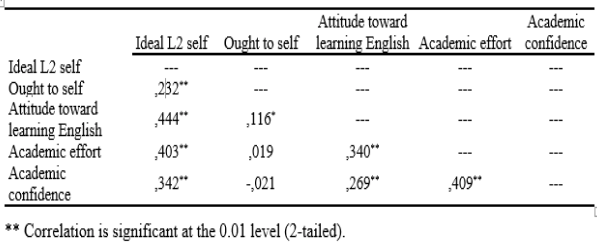
Almost all of the sub-dimensions of two variables were correlated positively with each other at a statistically significant level. The strongest correlation was observed between ideal L2 self and attitude towards English learning (r=.444), ideal L2 self and academic effort (r=.403), academic effort and academic confidence (r=.409). The only negative correlation was found between academic confidences and ought to L2 self (r=-0.21).
Moreover, it was decided to look at the relation between the two main variables academic self-concept and L2 motivational self-system (table 6).
Table 6
Correlation results
between ASC and MSS

The results of correlation analysis revealed significant (p < .01) correlation between affective variables ASC (r = .353), MSS (r = .413) and ICC.
For the Kazakhstani ELT pre-service teachers, the ICC does have a significant relation with academic self-concept (r=.363) as well as with L2 motivational self-system (r=.413). This means that, the higher Kazakhstani ELT pre-service teachers’ academic self-concept is, the higher his/her motivational self-system or the higher Kazakhstani ELT pre-service teachers’ L2 motivational self-system is, the higher his or her academic self-concept.
The descriptive analysis demonstrated that the participants had high levels of academic self concept in terms of academic effort and academic confidence. Moreover, they showed high levels of ideal L2 self and attitudes towards English learning within the concept of l2 motivational self system. However, ought to L2 self behaviour of participants was found to be in the medium level.
According to the results, the differences between male and female participants were found in terms of their levels of academic confidence and total academic self concept scores. These results were consistent with the results of the studies conducted by Wigfield, Battle, Keller, and Eccles, (2001), and Ireson and Hallam (2001) in which it was found that there was a difference in the academic self-concept of males and females. It was revealed in these studies that female students had a low level of academic self-concept. However, the studies in different contexts in which male participants demonstrated a higher academic self-concept than females and studies in which gender did not influence academic self-concept are also existed in the literature (Kling, et al., 1999; Hamed, Hussin, & Jam, 2017; Hossaini, 2002; Meece & Jones, 1996).
In terms of L2 motivational self system female participants demonstrated higher levels of ideal L2 self, whereas male participants showed more positive attitudes toward English learning. These results confirm the results of previous studies (Dörnyei, Csizér & Németh, 2006; Mori & Gobel, 2006; Ryan, 2009) which indicated that female learners outperformed male students in terms of their levels of Ideal L2 self.
Further, there was found a meaningful difference between two universities participants according to the components of academic self-concept and L2 motivational self-system. Specifically, Akhmet Yassawi University participants demonstrated higher levels of academic confidence and academic effort as well as ideal L2 self and attitudes towards English learning than Auezov State University participants. However, Auezov State University participants showed higher results in terms of their levels of ought to L2 self behavior, which indicated that Auezov State University pre-service English teachers are more instrumentally motivated. Kim’s (2012) assumption that ought to L2 self functions only at the cognitive level and there is no emotional attachment to it by the learner, so it has a weaker effect on learners L2 motivation than the ideal L2 self, was confirmed by the Auezov State university participants scores in terms of their levels of academic confidence and academic effort.
Further results revealed that participants’ years of study did not affect their level of academic confidence and academic effort, similarly their Ideal L2 selves and ought to L2 selves. The only difference among sophomore, junior and senior students was found in their attitudes towards English learning, where sophomore students showed more positive attitudes than their counterparts.
With respect to the relationship between L2 motivational self guides components and academic self concept components the results revealed positive correlations between all of the components of two constructs except academic confidence and ought to L2 self. The strongest correlation in a medium size was found between ideal L2 self and attitude towards English learning and the lowest correlation was indicated between ought to L2 self and academic effort.
In conclusion, it was clear from the results that in order to enhance academic self concept of pre-service English teachers in Kazakhstan it is of crucial importance to use motivational strategies to develop their desired future selves in terms of ideal L2 self, since these motivational behavior was found to be the most influential component of L2 motivational self system in the present study. The present study findings also supported the idea that the students are motivated by their future self images, such as being a fluent speaker of English and receiving promotion in the future, rather than by others’ expectations. Thus, there is a need to use motivational strategies for developing learners Ideal L 2 selves in the context where English is taught as a foreign language, in order to help learners to become more academically competent and to put more efforts to acquire higher degree of competence in English language. It has been proved by many researchers in different contexts that the L2 learners who are motivated in order to see themselves as competent L2 interlocutors in the future can direct their learning and acquire better linguistic competence. Therefore, EFL teachers and teacher educators should take into consideration the learners’ vision of L2 selves in developing their learning motivations. When the students can visualize themselves as successful English language speakers it activates their imagery and help to build desired future selves, which in turn, influence their level of academic self-concept.
It must be noted that the present study was conducted in two universities of Kazakhstan, and therefore the results cannot be generalized beyond this particular universities departments. More studies of this type are needed in Kazakhstani context with larger samples and different learners with various levels by conducting both qualitative and quantitative research methods to provide more convincing results, since the present study limited by qualitative method only with ELT program students.
Aliaga, M., & Gunderson, B. (2002). Interactive statistics. Virginia. America: Pearson Education.
Arseven, D. A. (1979). Akademik benlik tasarımı ile akademik başarı arasındaki ilişki konusunda bir inceleme. Yayınlanmamış Doçentlik Tezi, Hacettepe Üniversitesi, Sosyal Bilimler Enstitüsü, Ankara.
Balnaves, M., & Caputi, P. (2001). Introduction to quantitative research methods: An investigative approach. Sage.
Dörnyei, Z. (1998). Motivation in second and foreign language learning. Language teaching, 31(3), 117-135.
Dörnyei, Z. (2005). The psychology of the language learner: Individual differences in second language acquisition. Mahwah, NJ: Lawrence Erlbaum.
Dörnyei, Z. (2009). The L2 motivational self system. Motivation, language identity and the L2 self, 36(3), 9-11.
Dörnyei, Z., Csizér, K., & Németh, N. (2006). Motivation, language attitudes and globalisation: A Hungarian perspective. Multilingual Matters.
Fraenkel, J. R., & Wallen, N. E. How to design and evaluate research in education 2006. Mc Grawall Hill.
Gardner, R. C. (1985). Social psychology and second language learning: The role of attitudes and motivation. Arnold.
Hussin, F., Hamed, S., & Jam, S. M. (2017). Approaches to learning of engineering students: deep or surface. Int Acad Res J Soc Sci, 3(1), 122-127.
Higgins, E. T. (1987). Self-discrepancy: a theory relating self and affect. Psychological review, 94(3), 319.
Higgins, E. T. (1998). Promotion and prevention: Regulatory focus as a motivational principle. In Advances in experimental social psychology (Vol. 30, pp. 1-46). Academic Press.
Hossaini, S. M. (2002). Forecasting between self-esteem, parenting and gender among pre-university of students in Shiraz. University of Shiraz, Shiraz, Iran.
Ireson, J., & Hallam, S. (2001). Ability grouping in education. Sage.
Kim, T. Y. (2012). The L2 Motivational Self System of Korean EFL Students: Cross-grade Survey Analysis. English Teaching, 67(1).
Kling, K. C., Hyde, J. S., Showers, C. J., & Buswell, B. N. (1999). Gender differences in self-esteem: a meta-analysis. Psychological bulletin, 125(4), 470.
Liu, W. C., & Wang, C. K. J. (2005). Academic Self-Concept: A Cross-Sectional Study of Grade and Gender Differences in a Singapore Secondary School. Asia Pacific Education Review, 6(1), 20-27.
Markus, H., & Nurius, P. (1986). Possible selves. American psychologist, 41(9), 954.
Marsh, H. W. (1990). A multidimensional, hierarchical model of self-concept: Theoretical and empirical justification. Educational psychology review, 2(2), 77-172.
Meece, J. L., & Jones, M. G. (1996). Gender differences in motivation and strategy use in science: Are girls rote learners?. Journal of Research in Science Teaching: The Official Journal of the National Association for Research in Science Teaching, 33(4), 393-406.
Mori, S., & Gobel, P. (2006). Motivation and gender in the Japanese EFL classroom. System, 34(2), 194-210.
Muijs, D. (2010). Doing quantitative research in education with SPSS. Sage.
Reyes, L. H. (1984). Affective variables and mathematics education. The elementary school journal, 84(5), 558-581.
Ryan, S. (2009). Self and identity in L2 motivation in Japan: The ideal L2 self and Japanese learners of English. Motivation, language identity and the L2 self, 120-143.
Taguchi, T., Magid, M., & Papi, M. (2009). The L2 motivational self system among Japanese, Chinese and Iranian learners of English: A comparative study. Motivation, language identity and the L2 self, 36.
Wigfield, A., Battle, A., Keller, L. B., & Eccles, J. S. (2002). Sex differences in motivation, self-concept, career aspiration, and career choice: Implications for cognitive development. Biology, society, and behavior: The development of sex differences in cognition, 21, 93-124.
1. Prof. Dr., Educational Sciences Department, Gazi Faculty of Education, Gazi University, Teknikokullar, Ankara/Turkey. ygelisli@gmail.com
2. PhD Candidate, Hacettepe University, Graduate School of Educational Sciences, Department of Foreign Language Education, English Language, Teaching Program, Ankara/Turkey. lazura.kazykhankyzy@gmail.com
3. Prof. Dr., Preschool Education and Social Pedagogy Department, Pedagogy and Psychology Institution, Abai Kazakh National Pedagogical University, Almaty/Kazakhstan. a.mankesh@mail.ru
4. Prof. Dr., Preschool Education and Social Pedagogy Department, Pedagogy and Psychology Institution, Abai Kazakh National Pedagogical University, Almaty/Kazakhstan. a.mankesh@mail.ru
5. Lecturer, Preschool Education and Social Pedagogy Department, Abai Kazakh National Pedagogical University, Almaty/Kazakhstan. aig.31@mail.ru